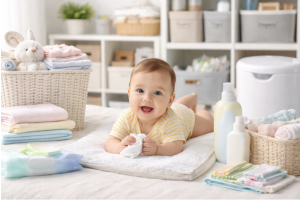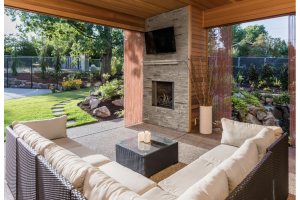Child-Friendly Home Design - 6 Tips for Creating Functional and Safe Spaces

Designing a home that is both functional and safe for children is a top priority for parents. Creating a child-friendly environment involves more than baby-proofing; it requires thoughtful planning and design to ensure that every part of the home is safe, comfortable, and conducive to a child’s development. Parents often face challenges in balancing style with practicality, ensuring that their home remains aesthetically pleasing while being a haven for their kids.
From choosing the right materials to organizing spaces efficiently, there are several key aspects to consider when designing a child-friendly home. This article will provide six essential tips to help parents create spaces that are not only safe but also promote learning and play.
1. Secure Windows and Doors
Securing windows and doors is crucial in preventing accidents and ensuring the safety of children. Windows, in particular, pose a risk if they are not properly installed and secured. Children can easily open them and potentially fall out, leading to serious injuries. Installing sturdy locks and child-proof window guards can significantly reduce these risks. Additionally, using window stops can prevent windows from opening more than a few inches, ensuring that children cannot climb through them.
If your windows are in poor condition, it’s important to consider replacing them to ensure the safety and efficiency of your home. Hiring professionals for this task can provide you with high-quality, secure windows that meet modern safety standards. A Local Window Replacement company can handle the installation, giving you peace of mind that the job is done correctly. New windows also provide improved insulation, reducing energy costs and enhancing the comfort of your home. Choosing window styles that fit your family’s routine can make day to day life feel calmer and more predictable. In busy homes, picture windows bring in steady natural light without adding moving parts that children might try to open or tamper with. They can work well in living rooms or play areas where you want clear views while keeping the setup simple.
2. Choose Durable and Easy-to-Clean Materials
Choosing materials that are durable and easy to clean is essential in a child-friendly home. Children are naturally curious and often make messes as they explore and learn. Using materials that can withstand wear and tear, as well as frequent cleaning, helps maintain a clean and hygienic environment. For instance, washable paint on walls can be easily wiped down, while laminate flooring is both durable and simple to clean.
Furniture and upholstery should also be selected with durability and ease of cleaning in mind. Stain-resistant fabrics for sofas and chairs can help keep your living spaces looking fresh and clean, even with the occasional spill or mishap. In high-traffic areas like kitchens and bathrooms, consider using materials like ceramic tiles or vinyl flooring, which are resilient and easy to maintain.
3. Create Safe Play Areas
Designating specific play areas within the home is important for both safety and organization. Play areas provide children with a dedicated space to explore, learn, and play while keeping the rest of the house tidy and clutter-free. These areas should be designed with soft flooring, such as foam mats or carpets, to cushion falls and minimize the risk of injury. Soft flooring materials also provide a comfortable surface for children to sit, crawl, and play on.
In addition to soft flooring, incorporating storage solutions within play areas helps keep toys organized and accessible. Storage bins, shelves, and toy boxes can prevent toys from becoming scattered throughout the house, reducing trip hazards and making it easier to keep the space clean.
4. Install Safety Gates and Guards
Safety gates and guards are essential for keeping children away from potentially hazardous areas in the home. Gates should be installed at the top and bottom of staircases to prevent falls. Additionally, placing gates at the entrances of kitchens and bathrooms can keep children out of areas where they might encounter hot surfaces, sharp objects, or toxic cleaning supplies. Safety gates come in various styles and sizes, making it easy to find options that fit your home’s decor and layout.
Furniture guards and corner protectors can also help prevent injuries. Sharp corners on coffee tables, countertops, and other furniture can pose a risk to young children who are just learning to walk. Installing guards on these corners can cushion any falls and protect your child from cuts and bruises. Similarly, outlet covers are a simple yet effective way to keep children from inserting objects into electrical outlets.
5. Incorporate Child-Friendly Furniture
Choosing furniture designed with children in mind can significantly enhance both the safety and functionality of your home. Look for furniture with rounded edges to reduce the risk of injury from bumps and falls. Additionally, selecting furniture that is appropriately sized for children can help them feel more comfortable and independent. For example, low shelves and storage units allow children to access their toys and books without assistance, encouraging self-reliance and organization.
Multifunctional furniture that grows with your child can also be a wise investment. Convertible cribs that transform into toddler beds or adjustable chairs that can be used at different stages of your child’s development provide long-term value. Non-toxic and environmentally friendly materials should also be a consideration when selecting furniture.
6. Foster an Interactive and Stimulating Environment
Creating an interactive and stimulating environment is crucial for a child’s cognitive and emotional development. Incorporating educational elements into your home design can make learning a natural part of everyday life. Wall decals with letters and numbers, chalkboard paint for drawing and writing, and activity tables with educational toys can all contribute to a learning-friendly environment. These elements can help spark curiosity and encourage children to explore and learn.
Natural light and ventilation also play an important role in creating a healthy and stimulating atmosphere. Ensure that windows are unobstructed to allow plenty of natural light to enter the rooms. Proper ventilation helps maintain good air quality, which is essential for health and well-being. Integrating these elements into your home design fosters a positive environment that supports your child’s growth and development.
Conclusion
Designing a child-friendly home involves thoughtful planning and a focus on safety, functionality, and development. By securing windows and doors, choosing durable and easy-to-clean materials, and creating designated play areas, parents can ensure their home is safe and welcoming. Installing safety gates and guards further enhances safety while incorporating child-friendly furniture and creating an interactive environment that supports a child’s growth and learning. Creating a home that is both functional and safe allows children to explore, learn, and grow in a secure and nurturing environment.






